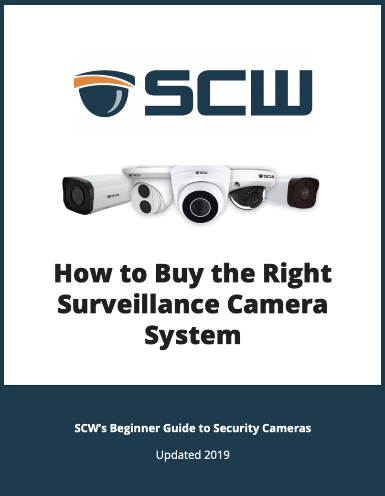A Brief History of US and Chinese Security Camera Manufacturing
How US Security Camera Manufacturers Missed the IP Camera Revolution and Don't Hold Most Relevant Patents Anymore
In the 1990's Bosch, Pelco, Honeywell, Sony, and Samsung all made great quality analog equipment. These companies make cameras with many different quality levels, but for the most part, they have generally kept a good name by using quality components in their equipment and by having good warranties* (*they will vary by retailer).
However, for reasons that we will explain, the big players in US security camera manufacturing, now often just relabel/modify slightly the products made by "The Big Two" Chinese companies that focus on IP cameras: Hikvision and Dahua.
For example, SCW's Vanguard line of NVRs (which launched in 2017) is produced in the same Chinese factory as Honeywell or GE's brand of NVRs that were launched in 2017. Why don’t Honeywell or GE make their own products? Here's a bit of history of what happened in the ‘90s and early 2000s.
In the Days of Analog
In the late 1990s, each of these companies were leading producers in surveillance. They were doing in the range of 5-15 billion dollars a year in security products, and most of that was in analog cameras. Now, analog is bunny-ears TV quality (or worse) resolution that is straight video signal down a copper wire. Analog looks like this:
Cameras with a small number of TV lines (less than 500)

Cameras with a large number of TV lines (700 or more)

Meanwhile...
Around the same time, HD IP cameras were starting to take off. HD IP cameras have a digital signal that travels on Cat5 cable. HD IP cameras look like this (although at the time, the top of the line models were about half this quality):
1080P Cameras (about 2.2MP)

4K Cameras (about 4x 1080P)

The Missed Opportunity
One CEO of a major brand called IP cameras a "fad," and, of the major US brands, no one jumped into making IP cameras.
Here are some quotes from a well-known trade magazine talking about the lack of activity by the major brands with digital IP cameras.
In the $6-$7 billion video security business this year (2011), about two-thirds of the cameras in production are analog, says Scott Schafer.
“The traditional providers of video surveillance equipment were slow to embrace and promote IP products in years past,”
How the Opportunity was Missed
AXIS Invents the IP camera; Geovision Popularizes it
Although Axis (which is a Swedish, not American company) was the first company to create an IP surveillance camera in 1996, it was primarily a mainframe and printer company at the time. One of the first companies to truly take off in the IP world was Geovision, a Taiwanese company. In the early 2000s, Geovision rose to take a significant portion of the IP camera market, however, Geovision, recognizing that new companies would be entering the digital surveillance camera market, decided to charge a yearly fee for every non-Geovision camera anyone tried to get to work with a Geovision device.
There was a reason for this fee. It was very difficult to support outside manufacturers’ products because everyone had a different language for communicating with their cameras and NVRs.
In 2008, two industry groups were formed: the Open Network Video Interface Forum (ONVIF) and the Physical Security Interoperability Alliance (PSIA). Both of these had the idea of creating a common language so that instead of hundreds of languages to support, there would only be one. ONVIF founders include vendors such as Axis, Bosch, Canon, Sony, Cisco, and Panasonic. PSIA's founding members include Honeywell, IBM, Stanley Security Solutions, Samsung, and Texas Instruments. This was a big step forward and allowed better interoperability. However, two competing standards for open communication across brands was not much better than none. The manufacturers fought over which open standard would be used.
The revenue that Geovision was getting from licensing fees was so significant that they decided to keep charging them even after PSIA and ONVIF were created. This was a disastrous decision. In a few short years, Geovision went from market share leader in IP surveillance cameras to an afterthought, because people did not want to pay their licensing fee. Meanwhile, "The Big Two," were winning a large percentage of market share, benefiting from a combination of a lower cost of production from being in China, having patented many of their early inventions, and the desire for standardization. Because The Big Two fully embraced ONVIF together, PSIA became more of an alarm and biometrics standard.
Why Didn't the Major US Brands Design Their Own IP cameras?
In retrospect, it is easy to criticize the decision. Very few people doubted that TV would fully transition to HD and the digital camera market had already transitioned. Why would surveillance be different?
The big companies thought that surveillance would not transition to HD for several reasons.
Number one, In the late 90s - early 2000s, the price was still high. If buying one expensive HD digital camera was a stretch, buying 8-30 HD surveillance cameras for a sizable system was out of reach at the time. What they failed to see was how quickly the price would change and how difficult it would be to jump in later.
Number two: The major US manufacturers’ distribution networks are largely through installers who are often not computer savvy, and early IP cameras were difficult to set up. The distribution network of installers was opposed to IP and, at the time, were a very powerful force in the industry (and still are). The two main distributor networks in the US are ADI and Tri-Ed, and they are billion-dollar buying networks and largely set the prices for the industry.
Number three: The big US manufacturers were already dealing with outsourcing problems and the cost of production driving up their analog products. In the late 1990s and early 2000s, there was already a transition from US-based production to overseas production. The people at the top had their hands full, and moving to IP cameras meant having to transition a massive amount of staff, from electrical engineers to computer programmers, at a time when they were already transitioning from American electrical engineers to Chinese or Indian electrical engineers. There might have been too much staff turnover for those companies to handle.
"There are companies that missed the whole curve (of the analog-to-digital transition) so they would have to source from a third-party company to get involved in it now,” Schafer says.
Most of the major US manufacturers sub-contract with one of "The Big Two" to create a unique product that is higher quality than "The Big Two" mass-market products sold under one of their brand names.
And that's what they did (and still do). Most of the big US brands now purchase their equipment from a factory in China, with "The Big Two" Chinese manufacturers, Hikvision and Dahua, making about 90% of IP cameras on the market.
The "Made in China 2025" Policy Cements China's Lead
In 2015, China passed the Made in China 2025 policy. This government program attempted to centralize all electronics manufacturers into China by putting all other providers out of business. This government policy subsidizes the cost of creating electronics by directly giving cash or loan incentives to electronics manufacturers (security cameras, TV, anything "high tech") for using Chinese parts and components. As an outsider, it is nearly impossible to calculate the exact subsidy that electronics manufacturers receive but it is significant--billions of dollars. Put another way, somewhere around one-fourth to one-third of the costs to manufacture electronic equipment (depending upon how many of the individual components were designed, developed, and manufactured in China) is being subsidized.
This cemented in place the technological advantages that the Big Two already possessed. Not only did American manufacturers have to compete with the lower-cost labor, more lax environmental laws and overcoming a technological deficit, but they also had to compete with manufacturing firms that could make a profit selling the equipment at, or even below, cost.
The United States government enacted no similar subsidy program for electronics manufacturing in the United States and most electronics manufacturing (not just cameras) fled the US to China.
On Subsidies
We hope that we don't come across as anti-subsidy here. Subsidies are actually often very important.
The United States has passed cash and loan subsidies of its own in other industries. For example, we subsidize the production of corn and oil. Most US based subsidies have to do with protecting our people in the time of war, but sometimes are the result of political lobbying.
It would be cheaper in the USA if it imported all food products from Mexico, for example, but if we ever went to war with Mexico, they could starve our population. The United States once got the majority of its oil from the middle east. Obviously, the 1970s proved that relying on other countries for our energy needs is a risk too substantial to ignore.
Sometimes subsidies are necessary to preserve military power (like the food example) or to prevent surrounding economic collapse (like the 70s energy crisis), but they absolutely are not free-market economics.
The US also subsidizes medical research, low-income housing, lots of exported goods, many loan and financial products, and automobiles.
On China
We also don't want to come across as anti-China here.
Developing countries, like China, have a major problem called the "middle-income gap" where manufacturing moves to their country because of low employment costs. Good factory jobs cause tons of people to move from rural to urban areas where factories are located. These people develop manufacturing skills. Wages rise as people gain more skills. As a higher percentage of their country gets a traditional "job" instead of working on a farm, wages rise again as the supply of unemployed workers dwindles. Eventually, wages rise to a point where the factories leave and go to another less-developed country.
This is why a program like "Made in China 2025" exists.
China has a right to subsidize whatever industries they choose, but if you are looking for the number one reason why nearly all electronic manufacturing has left the United States, the answer is the differing levels of subsidies.
The US Government puts a 10% Tariff on Many Chinese Goods
In 2018, the United States put a 10% tariff on much of the electronic equipment manufactured in China and threatened to increase that tariff to 25%.
We're not a political company, but this was a somewhat sloppy attempt to reverse the effect of the "Made in China 2025" policy, at least for the surveillance camera industry. For example, this tariff covers cameras but not recorders or brackets. Some companies have alleged that security camera systems, if imported together as a bundle, are not covered. (SCW disagrees with this view and pays tariffs on our imported cameras.) Some companies have alleged that if you import each item separately (camera, recorder, and hard drive), and then put them all in box together here in the USA, then you can say "USA manufactured," and escape the tariff. (SCW also disagrees with this view.)
The US Government increases the Tariff to 25%
On May 10, 2019, The US Government increased this Tariff to 25%.
President Trump signs Executive Order about "Foreign Adversary Technology."
On May 15th, 2019, President Trump signed an executive order directing the Secretary of Commerce to draft rules, within 150 days, banning US companies from doing business with "foreign adversary technology." Although this does not yet name any surveillance camera manufacturers by name, this is similar to the language used in the NDAA and will probably affect Hikvision and Dahua in some capacity.
The United States Government Bans the Big Two for US Government Use
On August 1, 2018, the US government passed a resolution, effective August 1, 2019, to prevent the federal government, and anyone else who is involved with national security, from making purchases of 360 surveillance cameras originally manufactured in four specific factories in China, including the "Big Two."
This ban was part of the 2019 National Defense Authorization Act (NDAA) and affects some or all Honeywell, Hikvision, Dahua, Lorex, Swann, LTS, Annke, Alibi, Laview, WBox, Interlogix, Flir, Bosch, ICRealtime, QSee, Panasonic, ADT, and Indigo Vision cameras. Please see our 2019 Federal NDAA guidelines knowledge base article for an overview of the legislation affecting the surveillance industry that goes into effect on August 1st, 2019.
SCW's Admiral and Imperial IP camera and NVR lines are not affected by this federal use ban.
US House Committee on Foreign Affairs Writes Letter Proposing Additional Sanctions on Hikvision/Dahua
On 3/4/19, additional Magnitsky Act sanctions on Hikvision and Dahua were proposed by the US House Committee on Foreign Affairs, because of their part in the Uyghur “re-education camps.” Magnitsky Act sanctions can result in the US government seizing equipment and assets, imposing fines and penalties, revoking licenses, or blocking the import of products, among other things.
What if my Government Contract or Other Requirements Force me to Buy USA-Made equipment?
Sometimes the federal government bids and contracts require that cameras be made in the USA. If your contract has those requirements, please make sure that whoever is approving the SCW order understands that our equipment is manufactured in China. Often you can get an exception to these rules.
Why we tend to get exceptions
(1) Quite frankly, there are not a lot of choices. If you want US-made cameras Arecont Vision and Avigilon are really the only options that we know of. Arecont has been rumored to be going bankrupt for years and just had an acquisition from a Chinese conglomerate fall through, post-agreement, which basically means that the cybersecurity concerns that force the government to buy cameras in the US are largely moot since their details were shared with a Chinese company. Avigilon is a Canadian company that does some manufacturing in the USA. It is also really a software analytics company and charges a larger amount per month for (very impressive) video analytics. Government agencies and City-Wide Surveillance use Avigilon a lot, but they are very expensive and sometimes overkill for some projects.
(2) Just don't connect it to the internet or your internal network. Most of the concerns from the Federal Government about security cameras stem from hacking concerns from hostile governments who could potentially force their camera manufacturers to put backdoors or compromised code into their devices. Whether foreign governments are forcing code changes or this sort of thing is happening accidentally is irrelevant. A group of Romanians, for example, recently hacked all the Washington DC police security cameras and they had nothing to do with the manufacturing of those cameras. Sony is not based in China and was recently found to have a massive number of devices with backdoor accounts. We don't think you can 100% prevent hacking, so we advise solving the issues differently. We have a Best Practices for Preventing IoT Hacks on our support portal (we also have may news articles listed on that page of recent hacks). One of the more unique ways that we sell camera systems is that we have subnets built into our NVRs. This helps reduce the number of devices that are hackable by placing the cameras on a network with a network. For federal governments who have hacking concerns and are looking to source products from the USA to reduce that risk, we actually recommend just creating a second, separate network connection so that there's a physical barrier between your cameras and computers with potentially sensitive documents or processes. Lastly, most of our military clients don't even allow access to the outside world at all for any camera systems. We strongly recommend this for all military bases whether you buy from us or any other manufacturer.
Mobotix is out of Germany and Axis is made in Sweden. They are both sometimes used on federal projects.
Distribution Networks and Price
The vast majority of security cameras are primarily sold through retailers or a distribution network such as ADI or Tri-Ed. ADI and Tri-Ed are billion-dollar distribution networks that negotiate prices on equipment for installers and surveillance experts. Their primary role is to keep the retail costs high and the installer price low, so that their installer network can make a profit selling the surveillance equipment. Bosch, Honeywell, Pelco, Sony, and Axis do most of their business through ADI, and Tri-Ed retailers, and so they care a lot about the price they sell the products to the distribution networks. The US manufacturers don't sell much retail, which means that they don't care that much what the retail price is.
Both the US manufacturers and the main distribution networks have an interest in keeping their retail prices high.
SCW systems are sold direct so that you can cut out the middleman and get a great surveillance system at affordable prices.
We typically charge 40% less than those who do.
Service
Our US-based tech support is included free with your order. It never expires.
To join ADT or Tri-Ed, you have to be a "value add," which means that you have to install, support, configure, or integrate the products. However, the costs, quality, and availability for support will vary by the installer or retailer.
Warranty
Our warranty is 3 years for all our digital products.
The warranties for the US manufacturers will vary by the installer or retailer.
That's why we're trusted by these companies:

Just Getting Started with Security Cameras?
Get the SCW Beginner's Guide!
New to security camera systems? Confused by Analog vs IP? Bullet vs Dome? Indoor vs Outdoor? Don't even know what PTZ means?
No problem! Download the SCW Beginner's Guide and get all your questions answered right away!

Lean on the experts
We'd be happy to work up a custom quote or take your floorplan and create a security coverage map.
Get aCustom Quote




